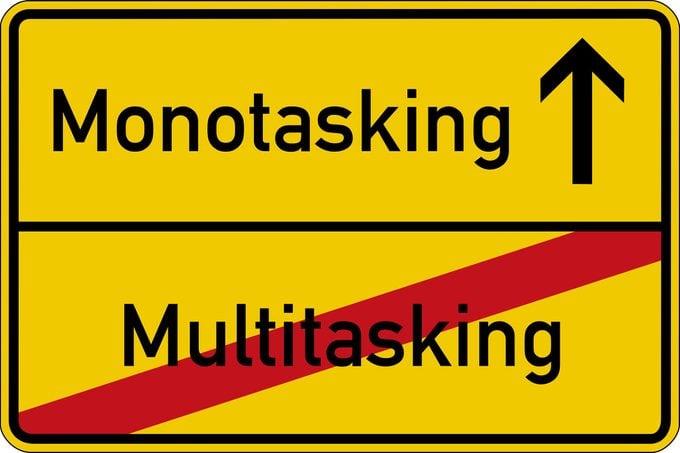What Is Monotasking—and Why It’s Better for You Than Multitasking
Updated: Mar. 13, 2024

Monotasking makes you more productive and is healthier for your brain—but what is it?
As I write this, I’m also checking email from colleagues, receiving text messages from my kids, getting notifications from my boss, searching Google on future article topics, posting a funny meme in a group chat and making coffee. It’s a classic multitasking situation. It’s also completely unproductive—I can’t focus.
Enter: monotasking. But what is monotasking, exactly? Read on to find out more about the new way to work on improving your concentration and time management skills.
What is monotasking?
Monotasking is pretty straightforward: Focusing on one task at a time. But, that’s harder than it sounds. The monotasking approach to time management encourages short, concrete tasks that are the sole focus of your attention for a block of time. Researchers say the goal of monotasking is to achieve “deep work.” This deep work is the ability to focus on a demanding task, one that requires more concentration—and to do that without distractions for an extended period of time.
Monotasking, in the end, is really about rethinking the way we work and changing our existing habits and mindsets.
Is multitasking bad for you?
Recent studies show that multitasking actually makes you a little dumber. According to a study by the Institute of Psychiatry at the University of London, emailing or looking at social media while talking on the phone actually lowers a person’s IQ more significantly than losing a night’s sleep, smoking cannabis or watching hours of mindless television. Chronic multitasking can actually decrease the grey matter density in parts of your brain.
Multitasking also takes a huge toll on productivity. This is because when we multitask we are constantly “task switching,” causing a “switch cost,” which is the time it takes to adjust to a new task. According to the American Psychological Association (APA), task switching over time can decrease productivity by as much as 40%. “Although switch costs may be relatively small, sometimes just a few tenths of a second per switch, they can add up to large amounts when people switch repeatedly back and forth between tasks,” said the APA. Multitasking may seem efficient on the surface but may actually take more time in the end and involve more errors.
How do I start monotasking?

1. Practice deep work
Instead of working in short bursts of 15 to 20 minutes, set aside two to four hours each day to tackle a single project with no interruptions, says Bryant Adibe, Chief Wellness Officer of Rush University System for Health in Inc. Magazine. This alone is almost guaranteed to lower your work stress.
2 Get rid of distractions in your work environment
Monotasking is just as much about eliminating distractions as it is about focusing. Shut down your phones, apps or anything else that sends notifications. Block out time slots on your calendar and set team communications to “do not disturb.” Listen to white noise, background noise or instrumental music without lyrics. Use headphones if necessary.
3. Set your intentions carefully
Sometimes the worst distraction is our own well-intentioned desire to be productive. Inc. Magazine suggests getting to the deep work by asking two important questions: 1) What could I do today that will bring me a sense of meaning and purpose? and 2) What are the two most important things I can do today that would have the greatest impact? Build your work day around the answers to those questions.
4. Schedule your day around peak performance times
Whether it’s early in the morning, right after lunch, or late at night, everyone has times of the day when they’re more productive. Once you identify your peak performance time, guard it! Schedule your deep work during these peak times.
5. Focus on what’s important
Try to remember what Adibe told Inc. Magazine: “At the end of our lives, no one will remember how quickly we responded to emails; and no one on their deathbed asks for more time to sit through another budget meeting. Instead, we look for more time to do and experience the things that give us meaning and a sense of purpose. That is at the core of mono-tasking—it is about rethinking the way we work so that we can more meaningfully engage with our environment.”
Sources:
- Inc. Magazine: Monotasking Keeps the Brain Healthy and You More Productive. Here are 5 Tips to Start Monotasking Today
- American Psychological Association: Multitasking: Switching costs
-
Chicago Tribune: Multitasking makes us a little dumber



















